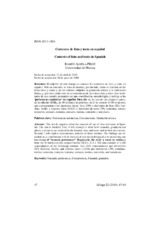Contextos de listo y tonto en español
Contexts of listo and tonto in Spanish
Autor
Almela Pérez, Ramón
Editor
UCOPressFecha
2010Materia
Preferencias semánticasCoocurrencias
Gradación sémica
Semantic preferences
Coocurrences
Semantic gradation
METS:
Mostrar el registro METSPREMIS:
Mostrar el registro PREMISMetadatos
Mostrar el registro completo del ítemResumen
El objetivo de este trabajo es conocer los contextos de listo y tonto en español. Más en concreto, se trata de mostrar, por un lado, cómo se realizan en los lemas listo y tonto y en sus eductos sufijados la gradación sémica y la valoración fórica, y, por otro, cuáles son las coocurrencias de los lemas listo y tonto. Los resultados de este estudio pretenden ser una contribución, metodológica y teórica, a las “preferencias semánticas” del español. Para ello me he servido del corpus Cumbre, de la editorial SGEL, de 40 millones de palabras; de él he tomado 1.430 contextos, que corresponden a los siguientes lemas: listo (349) y derivados de listo (32): listísimo, listillo y listorro; tonto (1.010) y derivados de tonto (39): tontísimo, tontito, tontorrón, tontuelo, tontaina, tontucio, tontino, tontolaba y tontolculo. This article inquires about the contexts of use of listo and tonto in Span-ish. The aim is twofold. First, I will attempt to show how semantic gradation and phoric evaluation are realised in the lemmas listo and tonto and in their derivatives. Second, I will explore cooccurrence patterns of these lemmas. The findings are in-tended as a contribution - both theoretical and methodological - to improving our knowledge of “semantic preferences”. Empirically, the study is based on evidence from the 40 million words corpus Cumbre (SGEL, S.A.). The data consists of 1,430 concordances of the following lemmas: listo (349 concordances) and derivatives (32): listísimo, listillo, and listorro; tonto (1,010) and derivatives (39): tontísimo, tontito, tontorrón, tontuelo, tontaina, tontucio, tontino, tontolaba, and tontolculo.

